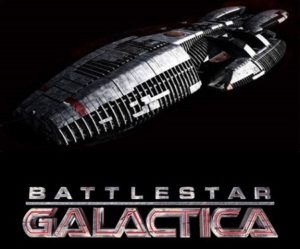
Late last month I finished a re-watching of the Battlestar Galactica reimagining which began as a miniseries in late 2003 and ran for four seasons from 2004 until 2009. I often mention that I don’t watch TV on this blog but it is probably more correct to state that I don’t sit down and watch commercial television and haven’t for about twenty years. I still watch television shows here and there though and this was one I was more fond of at the time. I also remembered disliking the direction the show went towards the end but it has been long enough since I watched it that I had forgotten why.
At the same time as I was re-watching the show, I also tried to watch the original series from 1978 but only got through about four episodes before I couldn’t watch anymore. It was the casino secretly run by bug monsters that got me in the end. I felt I should at least try though as the reimagining was all I knew of the series and wanted to have a serious look at the inspiration.
If you are reading and aren’t familiar with the show, it is a military science-fiction series that follows a conflict between humanity and their robotic creations called Cylons. The series is set after a previous war with the Cylons was fought to a truce and shortly before this truce is broken spectacularly with the destruction of all twelve human planets. Only the Battlestar Galactica and a handful a civilian ships survive the initial attack. The Galactica, unlike the other ships is able to avoid destruction because its computers are not networked. The Cylons are able to hack into the defense network and disable most other ships before many can even fire a shot. From there, reaching the legendary thirteenth colony of Earth and escaping the Cylons becomes the goal. The last point to add is that unlike the original series, the Cylons have managed to create human versions of themselves which was critical in the first strike as they were able to hide spies and saboteurs in the colonies some time before the attacks commenced.
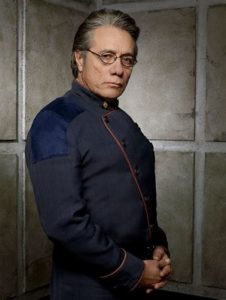
Commander William Adama
It is important to give some social context to the time because the show ended more than a decade ago and really quite a lot has changed since it finished its run in 2009. Probably the most important consideration is the state of the world at the time. It began a few years after the September 11th terrorist attacks during the first term of the George W. Bush Presidency. The United States was then in the early years of occupation of Afghanistan and Iraq was invaded the same year as the miniseries was released. There was opposition to the war around the world but it had the strong support of both major political parties in the United States.
This context is important because many episodes consciously incorporated contemporary discussion of terror, torture, abortion, war, peace, military occupation, martial law among other issues into the plot. The show was also notable for sex and sexual politics with women significantly represented in both leadership and the military of both the Human and Cylon factions. The cast was also significantly “diverse” though neither this or the gender politics were shamelessly pandered like is being done in virtually every medium now. Although certainly an issue at the time, the show also interestingly avoided homosexuality except in some indirect ways. As an example, I discovered in the process of writing this that a character called Felix Gaeta was apparently homosexual but I don’t recall it ever coming up during the series and it certainly wasn’t at all relevant. One reason I bring this up so early is because there is a new show (in the same universe) being developed which will probably go all out with this.
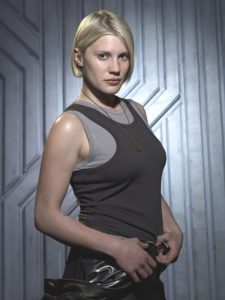
Kara “Starbuck” Thrace
I first watched the miniseries by chance when my father received a copy of it and I can recall being very impressed by it. Something else worth mentioning was that high-budget television shows were still rare at the time. Most shows were domestic sitcoms with laugh tracks or campy adventure shows like Hercules: The Legendary Journeys. It was shows like 24, Lost and this that really changed television during this time and this influence is still strong today. This is important because I remember being amazed by the visual effects, the elaborate sets, good writing and acting. The visual effects don’t hold up quite as well today but that is all but inevitable.
The show is military science fiction but as mentioned their is a heavy emphasis on social relationships and characters. The space battles are spectacular but relatively rare throughout the series. Part of the reason for this is that the humans are hopelessly outnumbered and rarely mount offensive against the far more advanced enemy. There is a little more emphasis on realism with the way aircraft move in space and the sound-effects in the vacuum are used sparingly. Battles are usually accompanied by tribal drums which effectively fill this void and add intensity to the action.
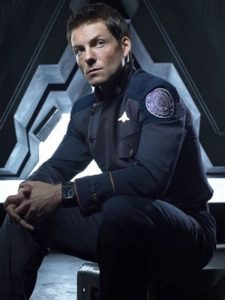
Lee “Apollo” Adama
Names or callsigns from the original series are used with William Adama as the commanding officer on the Galactica and his son Lee “Apollo” Adama as one of the many fighter pilots. Along with Kara “Starbuck” Thrace, Sharon “Boomer” Valerii who both have call signs of male characters from the original but are different characters. Gaius Baltar uses the name of Count Baltar, the traitor character from the original and is a traitor himself — though without the same motivations. Richard Hatch who played Apollo in the original also returns intermittently as Tom Zarek, a political radical that was imprisoned on one of the ships that ended up in the Galactica’s convoy. There are I’m sure, some other connections I am missing but the basic plot and character names are the most notable.
The vast majority of the show is on board the Galactica or within other ships in the fleet. The presence of the civilian fleet allows for a modern society in outer-space dynamic with the President of the colonies Mary Roslin who was the Education Minister at the time of the attack and who was the highest ranking civilian politician to survive. Reoccurring conflicts in the show are between military and civilian authority, civil rights, allocation of resources, police and general decision making. Adama’s response on first being hailed by President Roslin was, “Is this a joke?” and I was inclined to agree even late in the series. It is hard to believe in the situation they were in that military authority would not override civilian as a matter of necessity. The writers still do a good job of making all this believable though. This is also a vehicle for the many then topical issues covered in various episodes
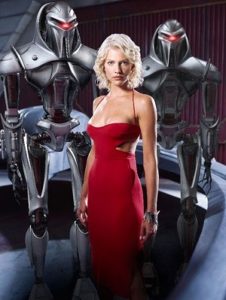
Number 6
The writers do take the effort to explain resource scarcity often with specific episodes devoted to solving such problems. Some examples early on are when they raid a Cylon fuel refinery as ore becomes scarce and another where their water supply is depleted in a terrorist attack. Most episodes have the characters consuming food, alcohol and ammunition like these resources are widely available. It is only right near the end of the series that the real strain begins with the Galactica beginning to literally fall apart.
The original series was created by Glen A. Larson who was a Mormon and the show had elements of that religion incorporated into it. There are strong themes about religion throughout with many of the Cylons being monotheistic while the humans of the Twelve Colonies have a pagan belief system using the Ancient Greek Gods. As with our society, there are characters that believe it completely, merely as a cultural observance and not at all. “So say we all” is as common response as “and with your spirit” is to Catholics. They also of course curse using “the gods” as well as “frak” standing in for our f-word much like “smeg” in Red Dwarf.
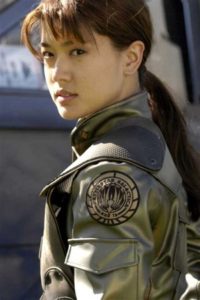
Sharon “Boomer” Valerii
Following the attacks on September 11th, 2001, there was a resurgence of atheism mostly as a reaction against Islam but in reality aimed at the much softer target of Christianity — Protestant Evangelicals in particular. This was notably promoted by Sam Harris, Richard Dawkins, Daniel Dennett and Christopher Hitchens. The latter was also one of the most vocal proponents of the wars the United States was waging at the time. Gaius Baltar can be seen as a younger version of Richard Dawkins, as the public face of reason and science in the colonies. Throughout the series there is a dialogue between the monotheistic Cylon “Number 6” played by the stunning Tricia Helfer and Gaius as well as an often chaotic love story.
Religious beliefs and prophecy also move the overarching story forward leading to discoveries of old settlements that guide the convey towards Earth. There are only a few instances that could be said to be explicitly supernatural throughout the series. One is with Kara Thrace whose “Viper’ aircraft is destroyed before she returns later on without a scratch on her or the aircraft and is suspected of being a Cylon from then on. After they find Earth at the end she disappears in front of Lee Adama, her on and off again love interest and one of the many untied threads left was who she was and where she went. Before this there is also a planet that both the Cylons and Humans converge on before a star goes supernova and reveals more clues to the location of Earth and five unknown Cylons within the Galactica’s convoy. This is all too much to be a coincidence but there is never anything undeniably supernatural shown. Ultimately, the exploration of religion goes nowhere except with regard to Gaius. He goes from atheist to a belief in one God as many of the Cylons do which eventually leads to him turning away from his previously cowardly and self-interested outlook on life and. Other characters remain much the same with then Admiral Adama still a firm skeptic to the end. What is also missing is any sort of responsibility or moral system that comes with believing in a god or gods.
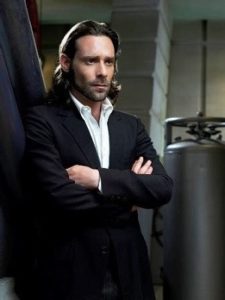
Doctor Gaius Baltar
There are twelve humanoid Cylons in the series of which there are also many doubles. A few are revealed immediately and there are the “Final Five” revealed later. A number of these Cylons are present within human society and some are sleeper agents that don’t realise what they are. The most notable of these is Boomer who doesn’t appear to be fully in control of her actions. The potential for anyone to be a Cylon naturally causes suspicion and paranoia within the fleet and Cylons discovered a usually blown out of the airlock. This doesn’t kill them as is it is later discovered their conscience (including the memory of their death), is resurrected in a new body.
As important characters are discovered to be Cylons and relationships develop, confusing moral quandaries arise. Questions of whether a Cylon can ever be trusted to change sides and be accepted among the fleet. Something of a civil war erupts in the Cylon fleet between those that want to ally with what’s left humanity and those who want to finish what they started. Given the series begins with twelve planets and billions and billions of humans being wiped out, it is hard to believe that either side could ever change there minds after such a conflict but they do.
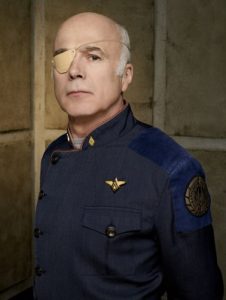
Executive Officer Saul Tigh
I’m sure Ronald D. More and David Eick who developed this series didn’t have it all planned out right to the end. The release of “The Plan” movie shortly after the series ended seems to have been made to fill in gaps and answer questions that came in the latter part of the series. This was mostly a clip show with new scenes integrated in-between to depict what was going on from the perspective of the Cylons. It presents many of them becoming hesitant or unsure about what they are doing. “Number 1” also known as John Cavil is shown to be the leader pushing these Cylons into action or using others more willing. It does a serviceable job of explaining away some of this incoherence but it is certainly a weakness that the series ultimately ended with clip-show explaining away plot holes.
Another aspect of the series I found hard to understand were the sometimes extreme emotional swings seen in characters. Where a character discovers he or she was a Cylon, they were somewhat understandable but this is not always the case. The most frequent was the relationship between Commander Adama’s second-in-command Saul Tigh and his wife Ellen. To be sure, these characters are both later revealed to be Cylons but even before this discovery both characters were completely over-the-top. One a hard-drinking Colonel and his wife, a shameless adulterous. Even the more grounded characters go to emotional extremes with Lee Adama who was usually (and often refreshingly), clear-headed being sent in emotional extremes in pursuit of the ever-flaky Starbuck. One could point to the extreme situation the characters were all in but I often found these derailing more often than not used as a plot device.
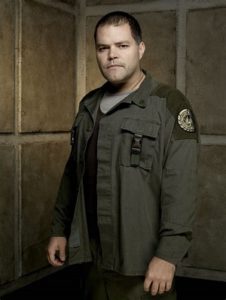
Chief Galen Tyrol
While I’m at my most critical, I would also like to mention the episodes that serve as nothing but filler. This seems to be a problem with many television series but I would say that the first two seasons at least were largely free of this. Seasons 3 and especially season 4 could easily have been much shorter and still covered what was necessary to bring the series to a close. There were detective stories, criminal investigations, court room dramas or love stories that didn’t do anything to move the plot along. Often these episodes were ones with thinly veiled political commentary mentioned earlier. These were sometimes relevant such as an episode where the “pro-choice” President makes the rational decision that abortion is a threat to the survival of humanity due to their being so few left. It is worth adding just how well the actress, Mary McDonnell resembles your typical female Democrat politician too. More often than not though, discussions like this are encompassed in one episode, go nowhere and don’t come up ever again.
The filler may be considered inevitable, but thankfully most of the series is still of high quality and especially the mini-series and the first two seasons. Episodes often stand-alone but this still tends to be some continuity and there is often direct continuation meaning you can’t really start viewing in the middle and expect to fully understand a single episode.
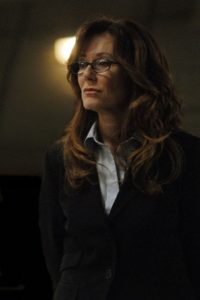
President Laura Roslin
While I am of the firm opinion that women should not be employed in the military or police forces in any capacity, I am able to suspend this belief in fiction. The original series had female pilots and military personnel so the new series wasn’t revolutionary on this front. Where it did differ was making Starbuck (played by Dirk Benedict in the original) into a female. The original Starbuck was a sort of Han Solo scoundrel with a heart of gold type character. Kara Thrace in this series is a pretty but boistrous and aggressive female and recognised as the best pilot on Galactica. Katee Sackoff who plays the character looks larger and more muscular than the average female but out of curiosity, I looked up her height and assuming what came up is reliable, she is only 5’6. To any serious minded person this makes the brawling and boxing she does in the series with the much larger men absurd. When the character was flying her Viper, she was just fine but whenever it came to blows with larger male characters, I could never quite switch my mind off.
The female Cylons have a bit more excuse for their physical prowess since Cylons are shown to have more physical strength than humans. So it is much easier to accept the taller Tricia Helfer being able to fight as she has superhuman abilities. Grace Park plays one of the Cylons and like Helfer, does multiple versions of herself. She is one of the more sympathetic of the characters, especially the version that becomes known as “Athena” later on and has a little girl with her copilot Helo. She also looks very cute in her Raptor pilot uniform which is not really relevant but I feel like mentioning it. Apart from this, the women are generally at their best when they are behaving like women and not kicking or punching much larger men. It is interesting that Lucy Lawless is also one of the Cylons and was at the time still fresh from beating up men in the dyke power fantasy series Xena: Warrior Princess. Battlestar Galactica just shows that women are best when they act like women.
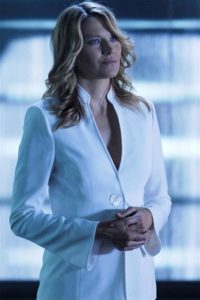
Number 3
The characters were very much of their time and ours with hook-up culture and the transience of sexual relationships. What was interesting was how the negative side was also explored. Promiscuity is common and marriage isn’t taken very seriously. The male and female Galactica personnel share washrooms and sleeping quarters. In the future it will probably be taken off television due to the lack of trannies but at the time, this was celebrated. What is refreshing is that it does show and somewhat confront the jealousy, damage and destruction wrought by loose living. Marriages are broken or fall apart, their are suicides, one man is cuckolded and generally quite a lot of the drama is caused by this loose living. Realistically, a military like this would not be able to stand against a strong enemy and the show obviously never goes far enough to show this but it is nice to see some understanding of what comes from living the way most of us now do.
I briefly mentioned the war drums that beat during the battles but I should give a special mention since I’m covering so much to the wonderful soundtrack by Bear McCreary who composed the soundtrack throughout and is really one of the most memorable parts of the series. It is not the type you’ll want to listen to for pleasure but it fits in very well with the world that has been created.
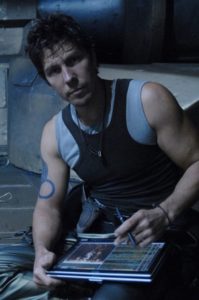
Samuel Anders
Right at the beginning, I mentioned not liking the way it ended. The first half of season 4 ends with the fleet arriving at Earth and finding it has long ago been destroyed. This sends most characters into existential and emotional spirals, ultimately leading to a mutiny. The planet we call Earth is discovered in the end in rather contrived and accelerated circumstances. There is an element of the Promised Land from Exodus hinted through the series and the President Laura Roslin succumbs to the cancer she has had from the beginning shortly after arriving. The relationship that had developed between her and Admiral Adama was quite touching though. Lee Adama has the surviving ships fly into the sun and the survivors (including loyal Cylons) then start again on different parts of the Earth. It than shows our world many thousands of years into the future with a preachy warning about destroying ourselves through war again. I didn’t like this but I thought the series as a whole ended well on a second viewing. They got where they set out to go in the end and that was satisfying enough.
I also watched the television movie of the prequel series Caprica a few months ago, which only lasted one season and was really unimportant as a background to this. I didn’t really enjoy it and though it was at best pointless though I know some really enjoyed it.
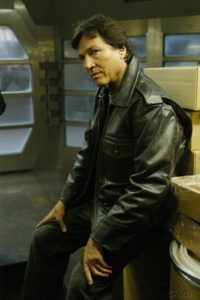
Tom Zarek
After rewatching the series, I wouldn’t say I really loved it but it was both enjoyable and memorable. It is not something I would recommend to someone who hadn’t watched it as it really is a creation of its time. As mentioned, I imagine the new series will really go all in with degeneracy particularly with regard to gender politics and what they call “representation”. There isn’t a whole lot of science-fiction television or film I like but even with all my criticism the reimagining of Battlestar Galactica is one of the better examples on television. The best is still to be found in novels though.
